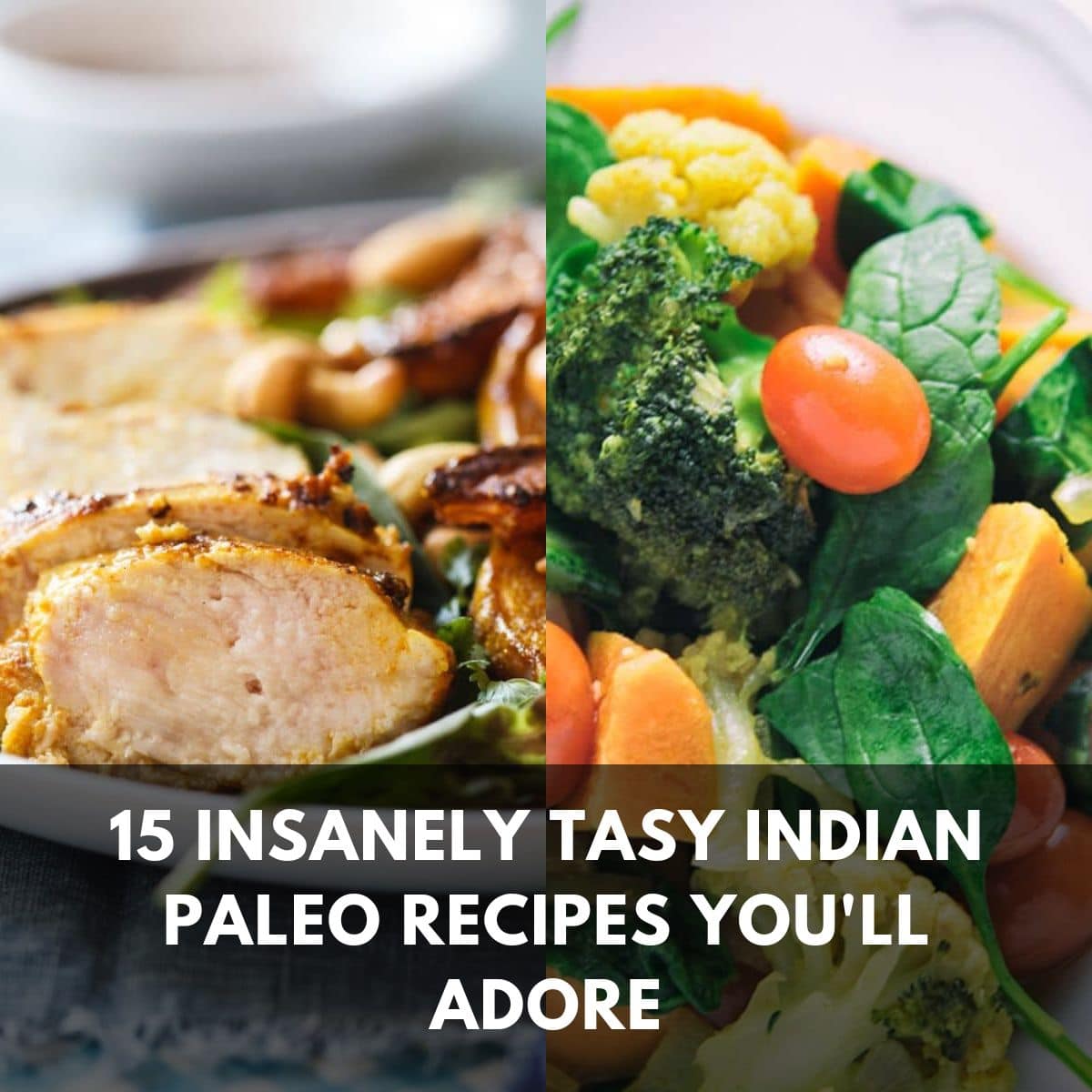Embark on a culinary journey where ancient Indian spices meet the modern principles of the Paleo diet. Imagine vibrant curries bursting with flavor, fragrant stir-fries brimming with texture, and delectable snacks that tantalize the taste buds – all while adhering to the health-conscious tenets of Paleo. This guide unveils the secrets to crafting delicious and nutritious Indian Paleo recipes, transforming traditional dishes into vibrant, flavorful meals that nourish your body and soul. We’ll explore the harmonious blend of traditional Indian cooking techniques and Paleo principles, guiding you through ingredient selection, flavor combinations, and plating techniques to create visually stunning and undeniably delicious meals.
From understanding the core tenets of the Paleo diet and its adaptation to Indian cuisine, to mastering the art of building complex flavor profiles with aromatic spices and herbs, this comprehensive guide will empower you to create authentic Indian Paleo dishes. We’ll delve into specific recipe categories, providing step-by-step instructions and troubleshooting tips to overcome common challenges. Prepare to discover a world of culinary possibilities, where healthy eating meets the rich and diverse tapestry of Indian flavors.
Understanding Paleo Principles in Indian Cuisine

The Paleo diet, inspired by the presumed diets of our Paleolithic ancestors, emphasizes whole, unprocessed foods while excluding grains, legumes, dairy, and refined sugars. Adapting this to the vibrant tapestry of Indian cuisine requires a thoughtful approach, focusing on the abundance of naturally Paleo-friendly ingredients and creatively reinterpreting traditional dishes. This involves understanding which core elements of Indian cooking align with Paleo principles and which need substitution or omission.
Paleo Principles and Indian Culinary Traditions
The core tenet of the Paleo diet is to consume foods our ancestors likely ate: lean meats, fish, fruits, vegetables, nuts, and seeds. Indian cuisine, with its rich history and regional diversity, naturally incorporates many of these elements. However, the widespread use of grains (rice, wheat), legumes (lentils, chickpeas), and dairy in many traditional dishes requires careful adaptation to fit within a Paleo framework. The challenge lies in preserving the complex flavors and textures characteristic of Indian food while adhering to the dietary restrictions. This involves focusing on spices, herbs, and cooking techniques to create dishes that are both delicious and Paleo-compliant.
Permitted and Prohibited Ingredients in Indian Paleo Cooking
Understanding which ingredients are permitted and prohibited is crucial for successful Indian Paleo cooking. The following lists provide a clear Artikel:
Permitted Ingredients: A wide array of fruits and vegetables commonly used in Indian cooking are naturally Paleo-friendly. This includes a rainbow of options like spinach, cauliflower, broccoli, eggplant, tomatoes, various peppers, mangoes, bananas, and many more. Lean meats such as chicken, fish (especially salmon and mackerel), and lamb are also excellent sources of protein. Healthy fats are readily available in coconut oil, ghee (clarified butter – use sparingly), and nuts like almonds and cashews. Spices form the backbone of Indian cuisine and are all permitted, adding depth and complexity to Paleo-friendly dishes.
Prohibited Ingredients: The primary exclusions are grains (rice, wheat, etc.), legumes (lentils, chickpeas, beans), and dairy products. Processed sugars, refined oils, and packaged foods are also strictly avoided. Many traditional Indian sweets and breads, unfortunately, fall into this category. It’s important to carefully read food labels to ensure that even seemingly Paleo-friendly products don’t contain hidden sugars or additives.
Traditional Indian Cooking Methods and Paleo Alternatives
Many traditional Indian cooking methods are inherently Paleo-friendly. Roasting, grilling, stir-frying, and slow cooking all work perfectly within the framework. However, some methods require adaptation. For instance, dishes relying heavily on flour-based sauces or gravies need creative substitutions. Coconut milk or pureed vegetables can often replicate the creaminess of traditional sauces. Similarly, the use of ghee should be moderate due to its fat content, and alternative cooking oils like coconut oil are preferred for their health benefits.
Nutritional Comparison: Traditional vs. Paleo Indian Dishes
The following table compares the nutritional profiles of some traditional Indian dishes with their Paleo adaptations. Note that the values are approximate and can vary based on specific ingredients and preparation methods.
| Dish Name | Traditional Ingredients | Paleo Adaptation | Nutritional Comparison |
|---|---|---|---|
| Chicken Tikka Masala | Chicken, yogurt, tomatoes, cream, spices, wheat-based sauce | Chicken, coconut milk, tomatoes, spices, cauliflower puree for sauce | Lower in carbohydrates and dairy, higher in healthy fats (from coconut milk) |
| Dal Makhani | Black lentils, kidney beans, butter, cream, spices | Cauliflower “dal” with coconut milk, spices, and healthy fats. | Significantly lower in carbohydrates and legumes, higher in healthy fats |
| Vegetable Biryani | Rice, mixed vegetables, spices, ghee | Cauliflower rice stir-fry with mixed vegetables and spices, cooked in coconut oil. | Lower in carbohydrates, similar in vitamins and minerals from vegetables. |
| Naan Bread | Wheat flour, yogurt, ghee | Plantain or cauliflower flatbreads | Lower in carbohydrates, higher in fiber and nutrients from the alternative ingredients. |
Flavor Profiles in Indian Paleo Recipes
The vibrant tapestry of Indian cuisine relies heavily on a masterful blend of spices, herbs, and aromatics to create complex and unforgettable flavor profiles. Adapting these techniques to a Paleo framework requires mindful ingredient selection, but the results are richly rewarding, offering a delicious and healthy alternative to traditional Indian dishes. This section will explore the key elements of creating flavorful Indian Paleo recipes, focusing on spice combinations, recipe examples, and step-by-step guidance for a flavorful curry.
Key Spices and Flavor Combinations
Indian cuisine boasts a vast array of spices, each contributing unique notes to the overall flavor profile. Understanding how these spices interact is crucial for creating balanced and delicious Paleo-friendly dishes. Common spices include turmeric (earthy and slightly bitter), cumin (warm and earthy), coriander (citrusy and slightly sweet), garam masala (a complex blend of spices), ginger (sharp and pungent), and chili powder (ranging from mild to intensely hot). These can be combined in countless ways to create different flavor profiles. For example, a combination of turmeric, cumin, and coriander forms the base of many curries, while the addition of chili powder adds heat. Garam masala provides a warm, complex backdrop to many dishes.
Examples of Indian Paleo Recipes with Diverse Flavor Profiles
Several Indian Paleo recipes highlight distinct flavor profiles. A spicy coconut curry, for example, utilizes coconut milk (a Paleo-friendly fat source), ginger, garlic, green chilies, and a blend of warming spices like cumin, coriander, and mustard seeds to create a fiery, satisfying dish. A tangy mango chutney, on the other hand, balances the sweetness of ripe mangoes with the sharpness of ginger and lime juice, creating a vibrant, refreshing condiment. For a sweeter option, consider a Paleo-friendly version of kheer, substituting coconut milk for dairy and using cardamom and saffron for a delicate sweetness and aroma. These recipes showcase the versatility of Indian spices and the potential for creating a wide range of flavors within a Paleo framework.
Step-by-Step Guide: Flavorful Indian Paleo Chicken Curry
This recipe focuses on building layers of flavor through careful ingredient selection and cooking techniques.
- Sauté Aromatics: Begin by heating coconut oil in a large pan. Add finely chopped ginger, garlic, and onions. Sauté until softened and fragrant, about 5 minutes. This forms the base of the curry’s flavor.
- Bloom Spices: Add cumin seeds, coriander seeds, and turmeric powder. Sauté for another minute until fragrant. This process, known as blooming, releases the essential oils in the spices, intensifying their flavor.
- Add Protein and Vegetables: Incorporate cubed chicken (or other Paleo-friendly protein) and chopped vegetables like cauliflower, bell peppers, and spinach. Cook until the chicken is browned and the vegetables are slightly tender.
- Simmer in Coconut Milk: Pour in full-fat coconut milk and add salt, pepper, and a pinch of cayenne pepper (optional, for heat). Simmer for 15-20 minutes, allowing the flavors to meld. The longer it simmers, the richer the flavor will become.
- Garnish and Serve: Garnish with fresh cilantro and a squeeze of lime juice before serving. This adds a final layer of freshness and brightness.
Using Herbs and Aromatics to Enhance Flavor
Beyond spices, herbs and aromatics play a significant role in enhancing the flavor of Indian Paleo dishes. Fresh cilantro, mint, and curry leaves add vibrant freshness and aromatic complexity. These herbs can be added towards the end of cooking to preserve their bright, fresh flavors. Other aromatics like lemongrass and kaffir lime leaves (if accessible) offer unique citrusy notes. Remember, using fresh, high-quality ingredients is key to achieving the most flavorful results. Avoid relying on pre-made spice blends or bottled sauces, as these often contain additives that are not Paleo-friendly.
Creating flavorful and authentic Indian Paleo recipes is a rewarding culinary adventure. By understanding the core principles of the Paleo diet and skillfully adapting traditional Indian cooking methods, you can unlock a world of delicious and nutritious possibilities. This journey involves embracing the vibrant spectrum of Indian spices and herbs, mastering techniques to build complex flavor profiles, and paying attention to the visual appeal of your creations. With practice and a touch of creativity, you’ll be crafting stunning, healthy, and undeniably delicious Indian Paleo meals that delight your senses and nourish your body. So, embrace the challenge, experiment with different flavors and techniques, and savor the delightful results of your culinary exploration.
User Queries
What are some good Paleo substitutes for common Indian ingredients like lentils or rice?
Cauliflower rice can replace rice, and vegetables like cauliflower, zucchini, or eggplant can be used as a base for dishes traditionally made with lentils.
Can I use coconut milk in Indian Paleo recipes?
Yes, full-fat coconut milk is generally Paleo-friendly and adds richness and creaminess to many Indian dishes.
How do I manage the sweetness in traditionally sweet Indian dishes while keeping it Paleo?
Use natural sweeteners like dates, or reduce the amount of sugar needed by enhancing the natural sweetness of vegetables and spices.
Are all nuts and seeds Paleo-friendly?
Most nuts and seeds are Paleo-friendly, but be mindful of portion sizes due to their calorie density.


